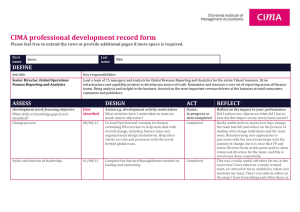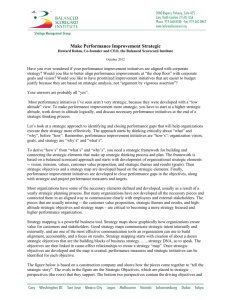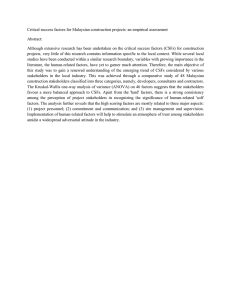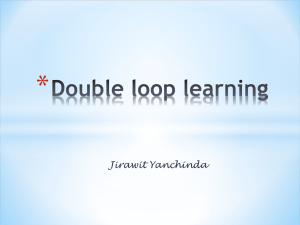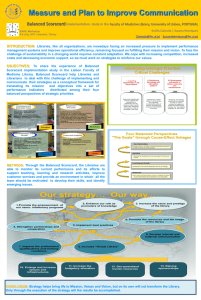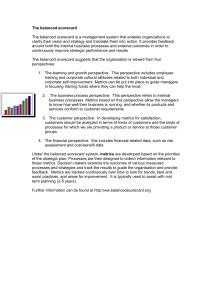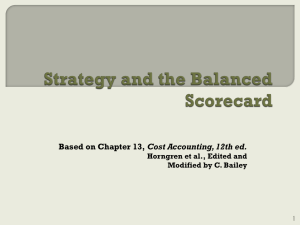Values, Vision, and Mission Values - ISSA-Sac
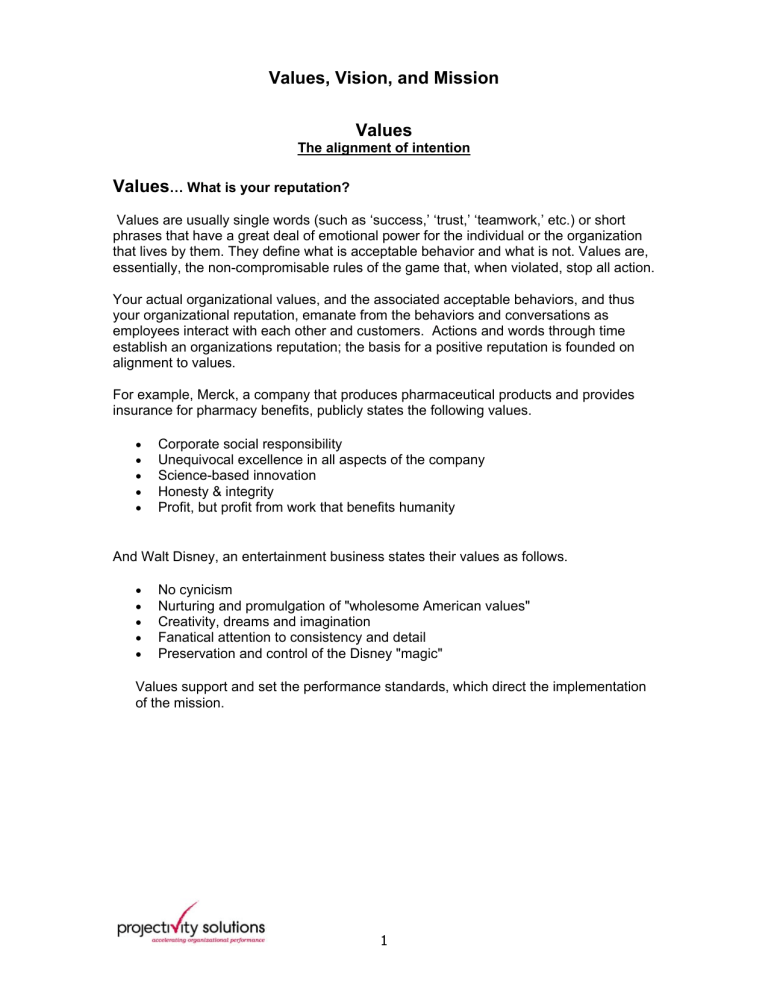
Values, Vision, and Mission
Values
The alignment of intention
Values
… What is your reputation?
Values are usually single words (such as ‘success,’ ‘trust,’ ‘teamwork,’ etc.) or short phrases that have a great deal of emotional power for the individual or the organization that lives by them. They define what is acceptable behavior and what is not. Values are, essentially, the non-compromisable rules of the game that, when violated, stop all action.
Your actual organizational values, and the associated acceptable behaviors, and thus your organizational reputation, emanate from the behaviors and conversations as employees interact with each other and customers. Actions and words through time establish an organizations reputation; the basis for a positive reputation is founded on alignment to values.
For example, Merck, a company that produces pharmaceutical products and provides insurance for pharmacy benefits, publicly states the following values.
•
•
•
•
•
Corporate social responsibility
Unequivocal excellence in all aspects of the company
Science-based innovation
Honesty & integrity
Profit, but profit from work that benefits humanity
And Walt Disney, an entertainment business states their values as follows.
•
•
•
•
•
No cynicism
Nurturing and promulgation of "wholesome American values"
Creativity, dreams and imagination
Fanatical attention to consistency and detail
Preservation and control of the Disney "magic"
Values support and set the performance standards, which direct the implementation of the mission.
1
Vision Statement
Organizational Inspiration… It is not what you do, but the difference you make
Vision
… What are you building?
Everybody is building something…. A company, an organization, or a department.
Well written Vision Statements answer the question: What is being built?… in three succinct sentences or less!
Effective Vision Statements need not to be long, but must clearly describe what you are building. A few key words will go along way. Create a picture of what your company will look like it one, three, or five years.
Vision Statements answer these questions:
•
•
•
•
•
•
•
•
What type of company is this?
What markets do we serve?
What is the geographic scope?
Who are our target customers?
What are the key products and services
How big will the company be?
What will be the revenues?
How many employees will there be?
To be effective, YOUR VISION should:
•
•
•
•
•
Clearly describe the visionary "outcome" of your Mission at a point in time well beyond an intuitive "extrapolation" of your current situation
Include and inspire all of those who do or will participate in the journey to the
VISION (investors, employees, suppliers, communities, etc., and even clients!)
Create a simple point of focus from which a strategic framework for thinking can be developed, and dynamically evolved
Serve as a metric against which progress can be measured
Be openly, widely and universally communicated, repeated, and accepted
The downside of not having a VISION , or having an ineffectual VISION
Without inspiration, the organization will become cynical, angry, disgusted, and pessimistic about their future. Commitment to "do what it takes" withdraws as does loyalty to the overall success. Personal focus becomes the order of the day and willingness to participate no less foster innovation, invention and improvement wane to non-existent. A case can be made for the common place "morale problems" of today being primarily sourced in ramifications and down line impacts of failure to have a clearly articulated VISION!
2
Mission Statement
Organizational Purpose… “If you don’t know where you are going, any road will get you there”.
Mission… Why does the organization exist?
Every company exists for a reason. The mission statement should be a clear and succinct expression of the enterprise's purpose for existence. It should incorporate socially meaningful and measurable criteria addressing concepts such as the moral/ethical position of the enterprise, public image, the target market, products/services, the geographic domain and expectations of growth and profitability.
The intent of the Mission Statement should be the first consideration for any employee who is evaluating a strategic decision. The statement can range from a very simple to a very complex set of ideas.
Mission Statements answer these questions:
• Why does the organization exist?
• What are we committed to providing to our customers?
• What promise are we making to our clients?
• What wants, needs, desires, pain, or problems do our products/services solve?
Mission Statements should contain?
The following are critical in defining "who" your organization is:
• The Purpose Statement
• The Business Statement
The purpose statement clearly states what your organization seeks to accomplish: Why does your organization exist? What is the ultimate result of your work?
Purpose statements usually include two phrases:
• an infinitive that indicates a change in status, such as to increase, to
• decrease, to prevent, to eliminate an identification of the problem or condition to be changed.
The business statement outlines the "business(es)" (i.e., activities or programs) your organization chooses in order to pursue its purpose. Specifically, you must answer,
"What activity are we going to do to accomplish our purpose?" For example, there are many ways to work on the problem of homelessness:
•
•
• to construct housing for homeless individuals to educate the public and advocate for public policy changes to provide job training to homeless individuals.
Failure to clearly state and communicate your organization's mission can have harmful consequences, including:
•
• organization members can waste time "barking up the wrong tree" the organization may not think broadly enough about different possibilities if
• its mission statement is unclear or overly narrow the organization may not realize when it is time to go out of business
3
Critical Success Factors
A focus on essential results… less is often more & never confuse motion with progress
Critical success factors (CSFs) are those things, which must go right for the organization to achieve its mission.
The advantages of identifying CSFs are that they are simple to understand; they help focus attention on major concerns; they are easy to communicate to coworkers; they are easy to monitor; and they can be used in concert with strategic planning methodologies.
Using critical success factors as an isolated event does not represent critical strategic thinking. But when used in conjunction with a planning process, identifying CSFs is extremely important because it keeps people focused. Clarifying the priority order of
CSFs, measuring results, and rewarding superior performance will improve the odds for long-term success as well.
Things that are measured get done more often than things that are not measured.
Each CSF should be measurable and associated with a target goal. You don't need exact measures to manage. Primary measures that should be listed include critical success levels (such as number of transactions per month) or, in cases where specific measurements are more difficult, general goals should be specified (such as moving up in an industry customer service survey).
A new approach to strategic management was developed in the early 1990's by Drs.
Robert Kaplan (Harvard Business School) and David Norton. They named this system the 'balanced scorecard'. The emphasis of this approach is to focus an organization on the essential results to achieve the vision and mission. The balanced scorecard is a management approach that enables organizations to clarify their vision and strategy and translate them into action. It provides feedback around both the internal business processes and external outcomes in order to continuously improve performance and results. The balanced scorecard transforms strategic planning from an academic exercise into the nerve center of an enterprise.
The balanced scorecard views an organization from four perspectives, creates organizational alignment to achieve results.
•
•
•
•
The Financial Perspective
The Customer Perspective
The Business Process Perspective
The Learning and Growth Perspective
4
Vision
&
Mission
5
